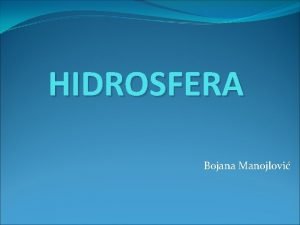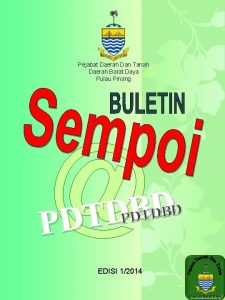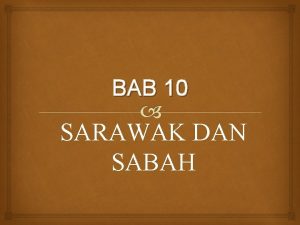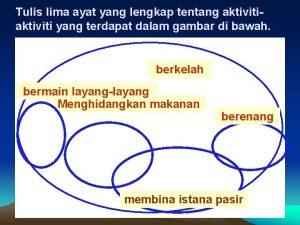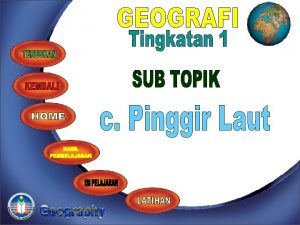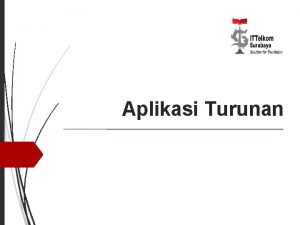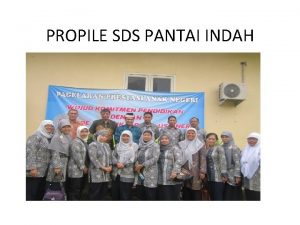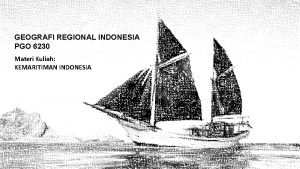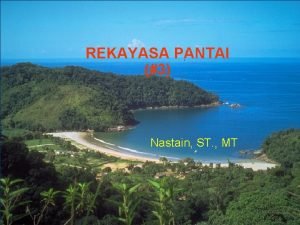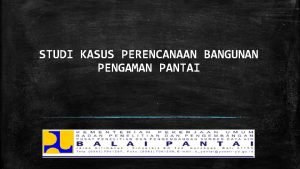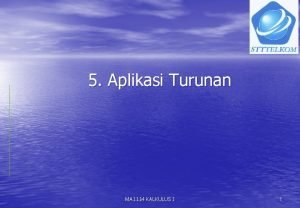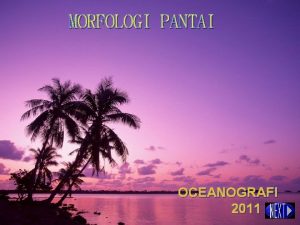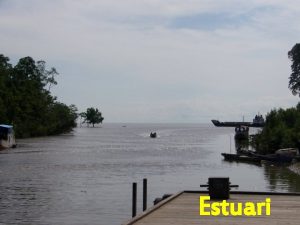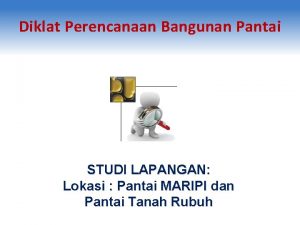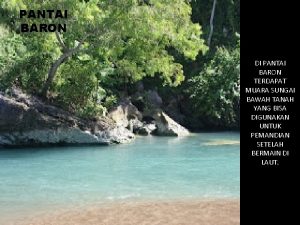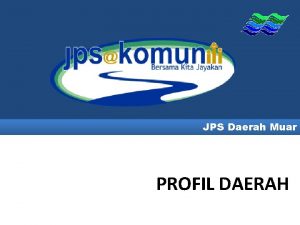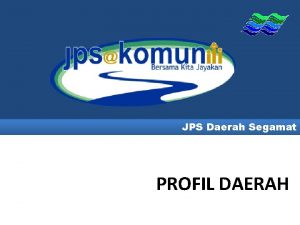ESTUARI ESTUARI DAERAH PANTAI SEMI TERTUTUP DIMANA AIR
















- Slides: 16

ESTUARI Ø ESTUARI : DAERAH PANTAI SEMI TERTUTUP DIMANA AIR LAUT BERCAMPUR DENGAN AIR TAWAR DARI DARATAN Ø LAGUNA : DIPISAHKAN DARI LAUT OLEH PANTAI BARRIER SISTEM ESTUARI Ø ESTUARI BERSIFAT SANGAT PRODUKTIF, KARENA: (1) TERDAPAT PENAMBAHAN-BAHAN ORGANIK SECARA TERUS MENERUS DARI ALIRAN SUNGAI (2) PERAIRAN UMUMNYA DANGKAL, CUKUP MENERIMA SINAR MATAHARI MENDUKUNG KEHIDUPAN TANAMAN (3) TEMPAT YANG RELATIF KECIL MENERIMA AKSI GELOMBANG DETRITUS DAPAT MENUMPUK (4) AKSI PASANG SELALU MENGADUK BAHAN-BAHAN ORGANIK YANG BERADA DI SEKITAR TANAMAN.

Value of Estuaries Ø Greatly influenced by river discharge and tidal mixing. l l Environmental conditions fluctuate widely. Biomass is high because estuaries have high nutrient levels. Species diversity is low because fewer species can cope with the wide fluctuations in temperature, salinity etc. “nursery grounds” • young stages develop in the estuary l l (abundant food; low predation may move offshore to adult habitats

Estuaries Ø greatly influenced by river discharge and tidal mixing. l l Environmental conditions fluctuate widely. Biomass is high because estuaries have high nutrient levels. Species diversity is low because fewer species can cope with the wide fluctuations in temperature, salinity etc. “nursery grounds” • young stages develop in the estuary l l (abundant food; low predation may move offshore to adult habitats

KARAKTERISTIK ESTUARI: TEMPAT HIDUP YANG BAIK UNTUK POPULASI IKAN Ø TEMPAT BERPIJAH DAN TEMPAT ASUHAN BEBERAPA SPESIES Ø TEMPAT PEMBUANGAN LIMBAH Ø TIPE ESTUARI: - Salt Wedge Estuary : campuran massa air tawar dan asin sedikit - Partially Mix Estuary : lebih umum, massa air sebagian tercampur oleh ombak dan pencampuran turbulen - Vertically Homogeneous Estuary: arus pasut mondominasi sirkulasi, tercampur total seluruh kolom air

Classification Ø One way of quantifying is by comparing the volume R of freshwater that enters from the river during one tidal period, with the volume V of water brought into the estuary by the tide and removed over each tidal cycle. Ø R is sometimes called the river volume, while V is known as the tidal volume.

Classification Ø Estuaries can be grouped into classes, according to their circulation properties and the associated steady state salinity distribution. The most important estuary types are 1. salt wedge estuary (R>>V) 2. highly stratified estuary (R>V) 3. slightly stratified estuary (R<V) 4. vertically mixed estuary (R<<V) 5. inverse or reverse estuary (R=0)

Salt Wedge

Highly Stratified Estuary Ø Ø Ø River volume R is comparable to but still larger than tidal volume V. Strong velocity shear at the interface produces internal wave motion at the transition between the two layers. The waves break and "topple over" in the upper layer, causing entrainment of salt water upward. Entrainment is a one-way process, so no fresh water is mixed downward. This results in a salinity increase for the upper layer, while the salinity in the lower layer remains unchanged, provided the lower layer volume is significantly larger than the river volume R and can sustain an unlimited supply of salt water Examples of this type of estuary are fjords, which are usually very deep and have a large salt water reservoir below the upper layer.

Fjord-Type Estuary

Slightly Stratified Estuary Ø River volume R is small compared to tidal volume V. Ø The tidal flow is turbulent through the entire water column (the turbulence induced mainly at the bottom). Ø As a result, salt water is stirred into the upper layer and fresh water into the lower layer. Ø Salinity therefore changes along the estuary axis not only in the upper layer but in both layers Ø This type of estuary is widespread in temperate and subtropical climates

Vertically Mixed Estuary River volume R is insignificant compared with tidal volume V. Ø Tidal mixing dominates the entire estuary. Ø Locally it achieves complete mixing of the water column between surface and bottom, erasing all vertical stratification. Ø As a result, vertical salinity profiles show uniform salinity but a salinity increase from station to station as the outer end of the estuary is approached Ø This type of estuary is found in regions of particularly strong tides; an example is the River Severn in England. Ø

Well Mixed

Slightly Mixed

Inverse or Reverse Estuaries Ø These estuaries have no fresh water input from rivers and are in a region of high evaporation. Ø Surface salinity does not decrease from the ocean to the inner estuary, but water loss from evaporation leads to a salinity increase as the inner end of the estuary is approached Ø This results in a density increase and sinking of high salinity water at the inner end. Ø As a result, movement of water is directed inward at the surface and towards the sea at the bottom, with sinking at the inward end.


DISTRIBUSI FAUNA Ø CRUSTACEA Gammarus pulex DI DAERAH PERAIRAN YANG SEDIKIT DIPENGARUHI AIR LAUT (TAWAR), > 12 KM DARI MULUT ESTUARI Ø Gammarus zaddachi DI DAERAH PERAIRAN (2 -25 ppt), BERJARAK 8 – 13 KM DARI MULUT ESTUARI. Ø Gammarus locusta DI DAERAH PERAIRAN LAUT (ASIN), SALINITAS > 25 ppt, BERJARAK < 7 KM DARI MULUT ESTUARI. Ø TERGANTUNG HABITAT ESTUARI (mkn, shelter, mijah): Platycephalus sp Ø TERGANTUNG HABITAT ESTUARI(kecuali mijah): Mugil sp. Ø JUVENIL DI ESTUARI, DEWASA DI LAUT : snapper Ø UMUM DI LUAR, MIJAH DI ESTUARI : herring
 Rijasi u hrvatskoj
Rijasi u hrvatskoj Prinsip tata ruang kantor
Prinsip tata ruang kantor Pt tanah air sentosa
Pt tanah air sentosa Pejabat daerah dan tanah daerah barat daya
Pejabat daerah dan tanah daerah barat daya Peta daerah pontian
Peta daerah pontian Jelaskan sistem kepimpinan kesukuan di sarawak
Jelaskan sistem kepimpinan kesukuan di sarawak Contoh ayat berkelah
Contoh ayat berkelah Foto aras bumi
Foto aras bumi Peta banjaran titiwangsa
Peta banjaran titiwangsa Tentukan selang kecekungan dan titik belok fungsi berikut
Tentukan selang kecekungan dan titik belok fungsi berikut Sd pantai indah cilincing
Sd pantai indah cilincing Plth pantai baru
Plth pantai baru Rekayasa pantai
Rekayasa pantai Pantai
Pantai Kalkulus
Kalkulus Pantai bergisik
Pantai bergisik Haptophyceae
Haptophyceae
